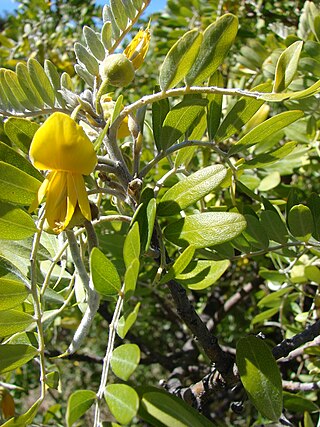
Sophora is a genus of about 45 species of small trees and shrubs in the pea family Fabaceae. The species have a pantropical distribution. The generic name is derived from sophera, an Arabic name for a pea-flowered tree.
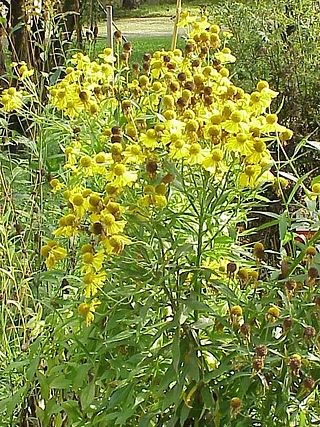
Helenium is a genus of annuals and herbaceous perennial plants in the family Asteraceae, native to the Americas.

Dermatophyllum secundiflorum is a species of flowering shrub or small tree in the family Fabaceae that is native to the Southwestern United States and Mexico. Its common names include Texas mountain laurel, Texas mescalbean, frijolito, and frijolillo.

Hymenoxys is a genus of plants in the sunflower family, native to North and South America. It was named by Alexandre Henri Gabriel de Cassini in 1828.
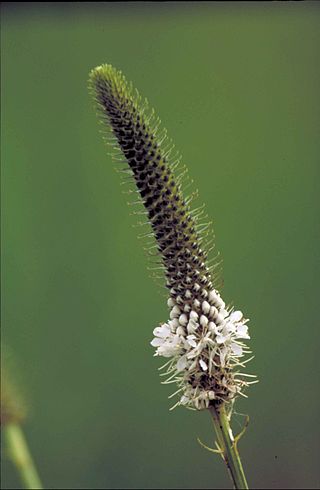
Dalea is a genus of flowering plants in the legume family, Fabaceae. Members of the genus are commonly known as prairie clover or indigo bush. Its name honors English apothecary Samuel Dale (1659–1739). They are native to the Western hemisphere, where they are distributed from Canada to Argentina. Nearly half of the known species are endemic to Mexico. Two species of Dalea have been considered for rangeland restoration.

Isocoma, commonly called jimmyweed or goldenweed, is a genus of North American semi-woody shrubs in the family Asteraceae. It is found in the semi-arid areas of Southwestern United States and Mexico.

Hedeoma is a genus of flowering plants in the mint family, Lamiaceae. It is native to North and South America. They are commonly known as false pennyroyals.
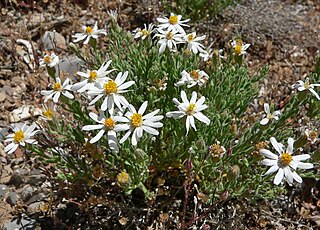
Chaetopappa is a genus of plants in the family Asteraceae which are known generally as leastdaisies.

Styphnolobium japonicum, the Japanese pagoda tree is a species of tree in the subfamily Faboideae of the pea family Fabaceae.

Hymenopappus is a genus of flowering plants in the daisy family. Many species are known as woollywhites.
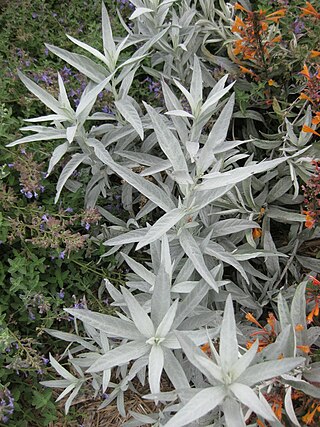
Artemisia ludoviciana is a North American species of flowering plant in the daisy family Asteraceae, known by several common names, including silver wormwood, western mugwort, Louisiana wormwood, white sagebrush, lobed cud-weed, prairie sage, and gray sagewort.

The peyote is a small, spineless cactus which contains psychoactive alkaloids, particularly mescaline. Peyote is a Spanish word derived from the Nahuatl peyōtl, meaning "caterpillar cocoon", from a root peyōni, "to glisten". Peyote is native to Mexico and southwestern Texas. It is found primarily in the Sierra Madre Occidental, the Chihuahuan Desert and in the states of Nayarit, Coahuila, Nuevo León, Tamaulipas, and San Luis Potosí among scrub. It flowers from March to May, and sometimes as late as September. The flowers are pink, with thigmotactic anthers.
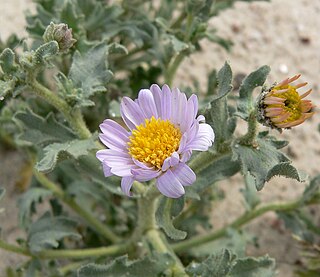
Arida is a genus of flowering plants in the daisy family, Asteraceae.

Hilaria is a genus of North American plants in the grass family. Members of the genus are commonly known as curly mesquite. They are found in the Southwestern United States, Mexico, and Guatemala.
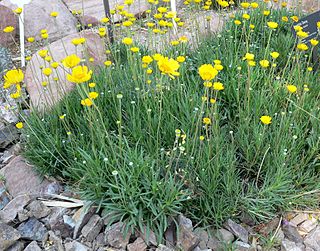
Tetraneuris, commonly known as four-nerve daisy or bitterweed, is a genus of North American plants in the sneezeweed tribe within the daisy family.

Dermatophyllum gypsophilum is a rare species of flowering plant in the legume family known by the common names Guadalupe Mountain necklacepod, Guadalupe mescalbean, and gypsum necklace. It is native to New Mexico and Texas in the United States, and it is known from one location in Chihuahua in Mexico.
Brickellia lemmonii, or Lemmon's brickellbush, is a North American species of flowering plants in the family Asteraceae. It is native to northeastern and north-central Mexico and the southwestern United States.

Sanrobertia is a genus of flowering plants within the subtribe Symphyotrichinae of the family Asteraceae. It is monotypic, meaning there is only one species within the genus. Sanrobertia gypsophila is a rare endemic known only from Nuevo León, Mexico.
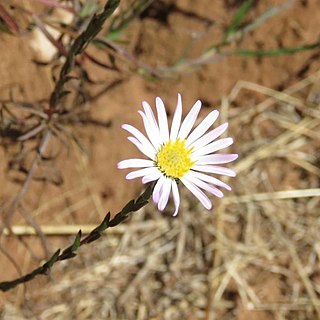
Symphyotrichum moranense is a species of flowering plant in the family Asteraceae. It is a perennial and herbaceous plant that reaches about 90 centimeters in height. Its white ray florets open October through April, and it is native to Mexico.

Symphyotrichum chihuahuense is a species of flowering plant in the family Asteraceae that is native to Chihuahua and Durango, Mexico. It is perennial and herbaceous and reaches heights of 20–35 centimeters. Its white ray florets open June–September, and it grows in grasslands and oak–pine woods at elevations 1,800–2,500 meters.




















